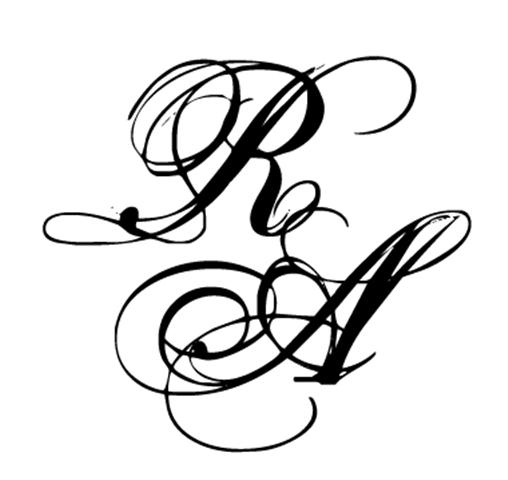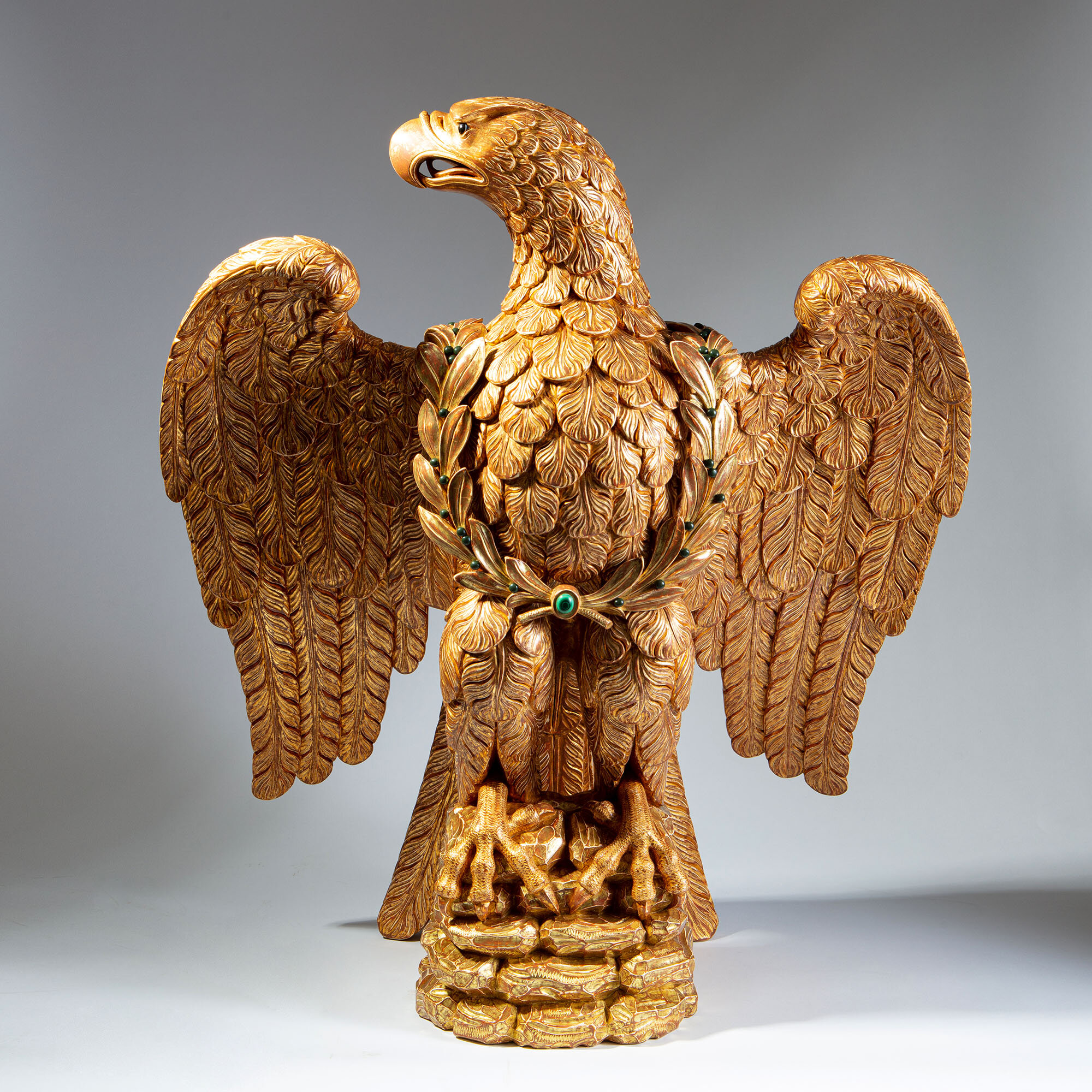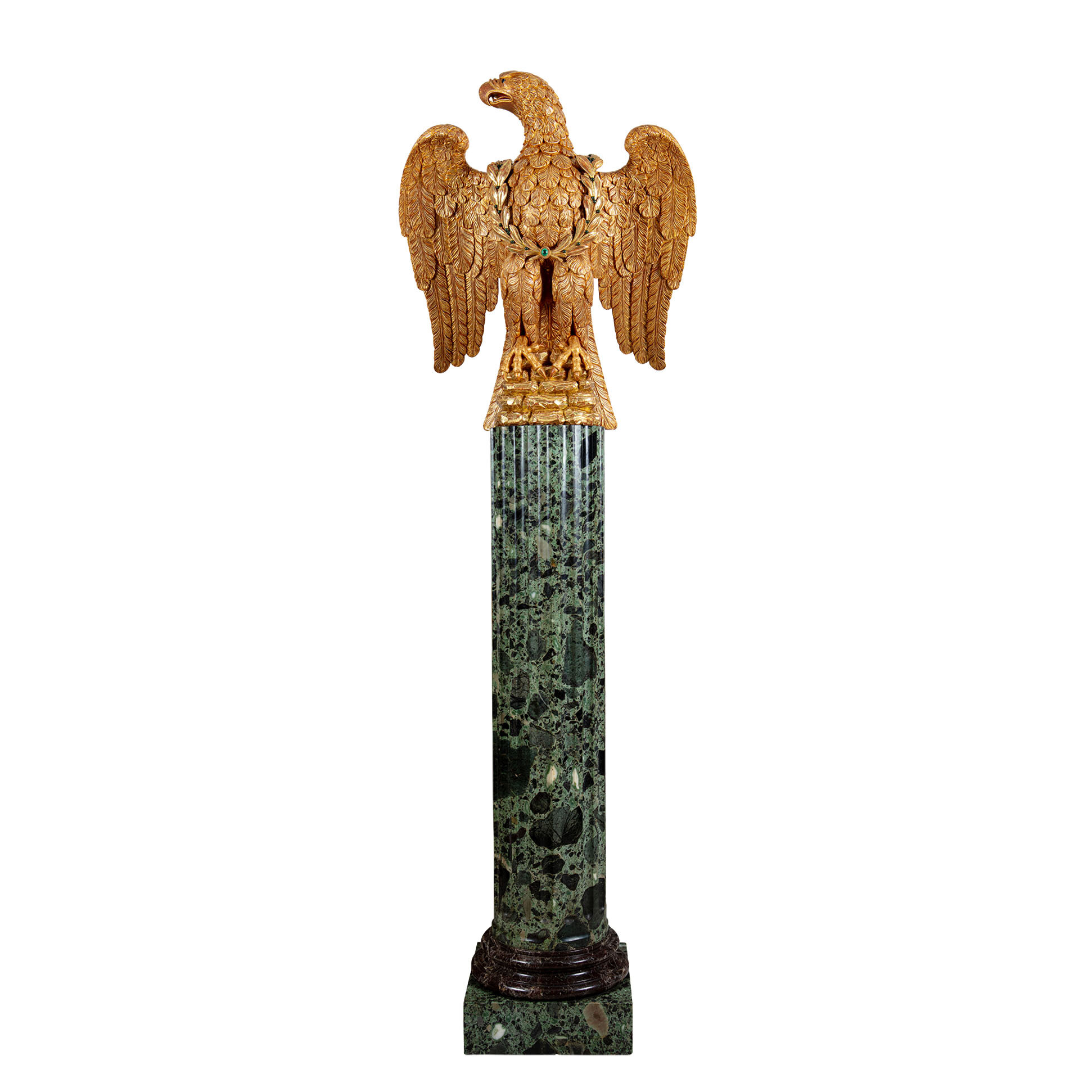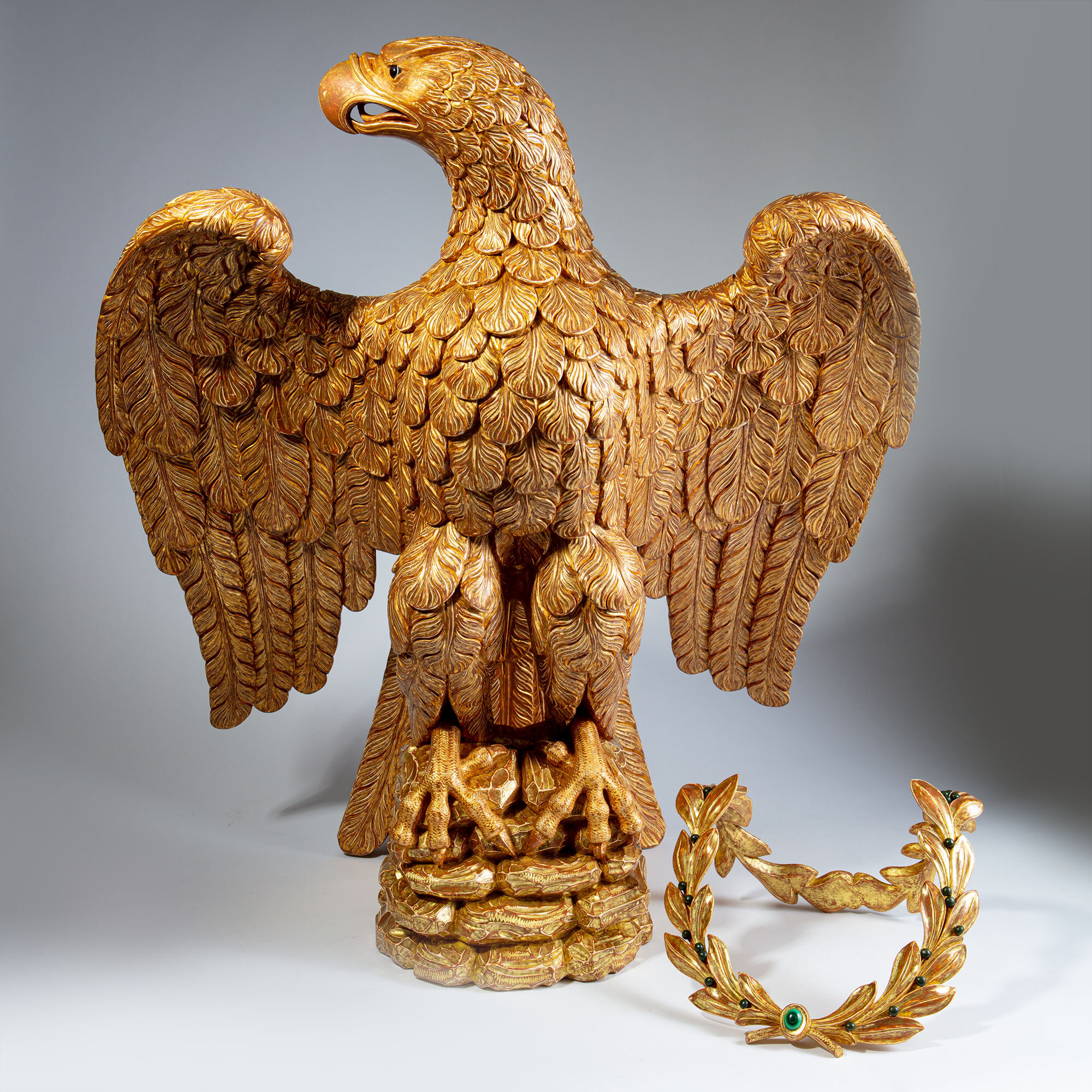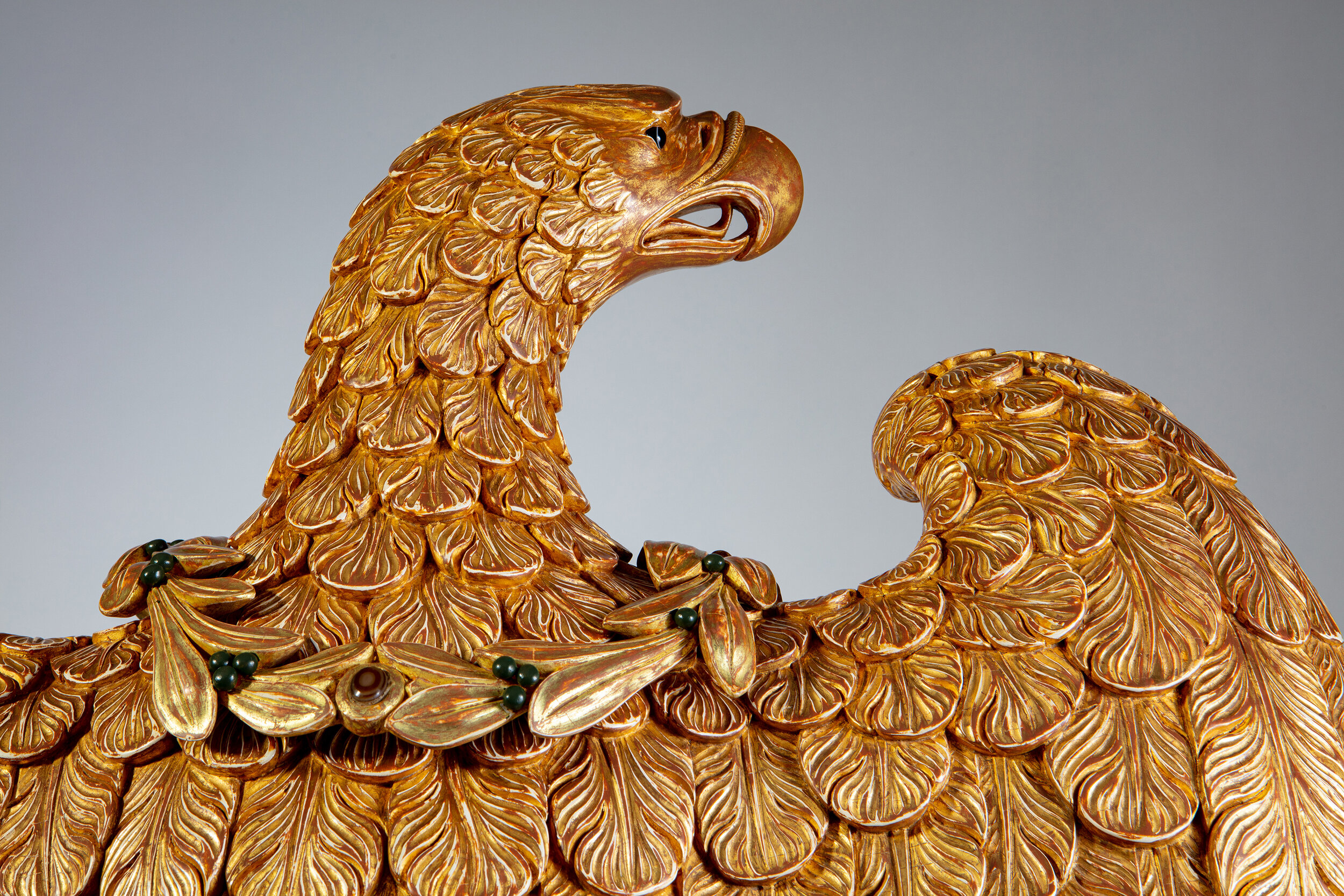This is a truly magnificent carved giltwood eagle, his wings held partially outstretched, his proud head with powerful hooked beak and all-seeing eyes of polished ring-banded black agate, turned to look towards the right, the whole describing a bird with legendary powers of flight and vision. He is the king of birds, proud and alert, his curved and powerful talons clasping a carved circular post perch of laid stones, his status confirmed by the separate carved laurel wreath – the classical symbol of martial and sporting victory - with a cabochon of malachite centred in the tied bow, enhanced throughout by the discreet inclusion of polished dark malachite beads.
The carving of this piece is exceptional, beautifully defined, matched, and balanced, without question a work of superb quality. And the subtle depths and highlights of the burnished gilding reveal the hand of another master craftsman at work, an impeccable finish of such artistry and skill is only achieved by equal shares of experience and expertise. The age-old skills of carving and gilding combine effortlessly and splendidly to accentuate the stature and prestige of this wonderful bird.
Eagles appear in statuary and furniture, metal ware and marble, ceramics, and other objets d’art. The magnificent mirror frames and cabinet stands of the late 17th Century onwards, carved in soft wood and then gilded, turned for inspiration to both the ancient and natural world, and also of course to mythology and religion. A carved eagle crested many 18th Century mirror frames and Regency convex mirrors, eagles with outstretched wings support marble topped side or console tables; and eagle heads frequently feature on the arms and seat supports of fine giltwood chair frames.
It may well surprise you to learn that our astonishingly beautiful and quite outstanding representative of the twin arts of wood carving and water gilding is of relatively recent origin. An exceptionally fine decorative piece, this proud eagle reassures us that true craftsmanship still exists in our tumultuous and rapidly changing world. The carving was inspired by a special piece of jewellery belonging to our client: a striking diamond brooch in the form of an eagle, a much admired piece and a particular favourite.
The brooch in question is of the French Imperial Eagle. Worked in white gold, set with old cut diamonds and with a ruby eye, the eagle bears the laurel wreath of victory, the wreath made in yellow gold with the leaves enamelled green. The brooch dates from the 1930s and was made or retailed by The Goldsmiths & Silversmiths Co of 112 Regent Street, London. The emblem of the eagle with outspread wings was the ensign of the kings of Babylon and Persia. As the ancient symbol of power and victory the Romans adopted it for the standards of the Roman legions; and later during the period of the First Empire (1803-15), in Napoleon's Grande Armée, the eagle topped the staffs of the French regimental standards.
This symbolic eagle – particularly as depicted by our client’s brooch – has a unique connection to the Royal Scots Greys (2nd Dragoons). Dating back to 1681 the Royal Scots Dragoon Guards are the most senior of the Scottish regiments and are celebrated as the oldest surviving Cavalry Regiment of the Line in the British Army, retaining their horses as late as 1941, the last British cavalry regiment to adopt motorised transport.
Following the Glorious Revolution of 1688 the regiment supported King William III, fighting for him against the Jacobites. The entire regiment attended a royal inspection in London in 1689 mounted on ‘greys’ (horses with white or dappled-white hair) thus gaining itself the nickname of ‘The Scots Grey Dragoons’ – the name only becoming part of its official title nearly 200 years later, when the regiment was renamed the 2nd Dragoons (Royal Scots Greys).
The regiment’s sole Napoleonic battle honour was seized on 18 June 1815 at the Battle of Waterloo. In this attack, Sergeant Charles Ewart captured the eagle standard of the French 45th Regiment of the Line. The gilded bronze eagle is displayed in the Royal Scots Dragoon Guards Museum at Edinburgh Castle and is one of their proudest treasures. Significantly, the image of the captured eagle was later incorporated into the cap badge of the Scots Greys.
HM The Queen has been Colonel in Chief of the Scots Greys from the date of her accession in 1952. Her diamond and enamel regimental brooch, identical in design to our client’s piece, was presented to her in 1956 and was made by Garrard & Co, the jewellers so long associated with royalty and the company to which The Goldsmiths & Silversmiths Co Ltd was amalgamated in 1952 – hence the certain connection between Her Majesty’s regimental brooch and our client’s inherited piece.
Our proud and supremely wonderful eagle is displayed upon a fine polished column of verde antico, a serpentinite breccia most often a deep, dark green enhanced by distinctive white veins, and notable as a stone which takes a high polish. The stone was greatly favoured by the monumental builders of the Byzantine and Ottoman Empires so we felt it a most fitting choice to serve as the eyrie of an Imperial Eagle.
A few more eagle notes:
The eagle was regarded as sacred to Jupiter (the Greek Zeus), the supreme ruler of the Roman gods and mortals, and the chief of the twelve Olympians.
After the death of Julius Caesar the Romans deemed him a god, an official and symbolic recognition which established a precedent for later emperors. The ceremony after the death of an emperor included the release of an eagle believed to carry the emperor’s soul to heaven. The 17th Century poet John Dryden (1631-1700) alludes to this custom in his stanzas written after the funeral of Oliver Cromwell, ”Officious haste did let too soon the sacred eagle fly.”
Medieval folk considered the eagle as a symbol of Christ’s Ascension and also saw the bird as an attribute of John the Evangelist - the eagle being King of the Birds, the one who flies closest to heaven. Many of our churches have carved lecterns with the bible rest supported by a carved eagle – the bird of course also recognised as the natural enemy of the evil serpent - his outstretched wings representing the Old and New Testaments of the Christian Bible.
Coming right back down to earth, the not uncommon pub names of The Golden Eagle and The Spread Eagle derive from over 800 years ago all the way back to the Crusades, their imagery taken again from the armorial devices of the Emperors of the East.
Written by Clare Buxton
